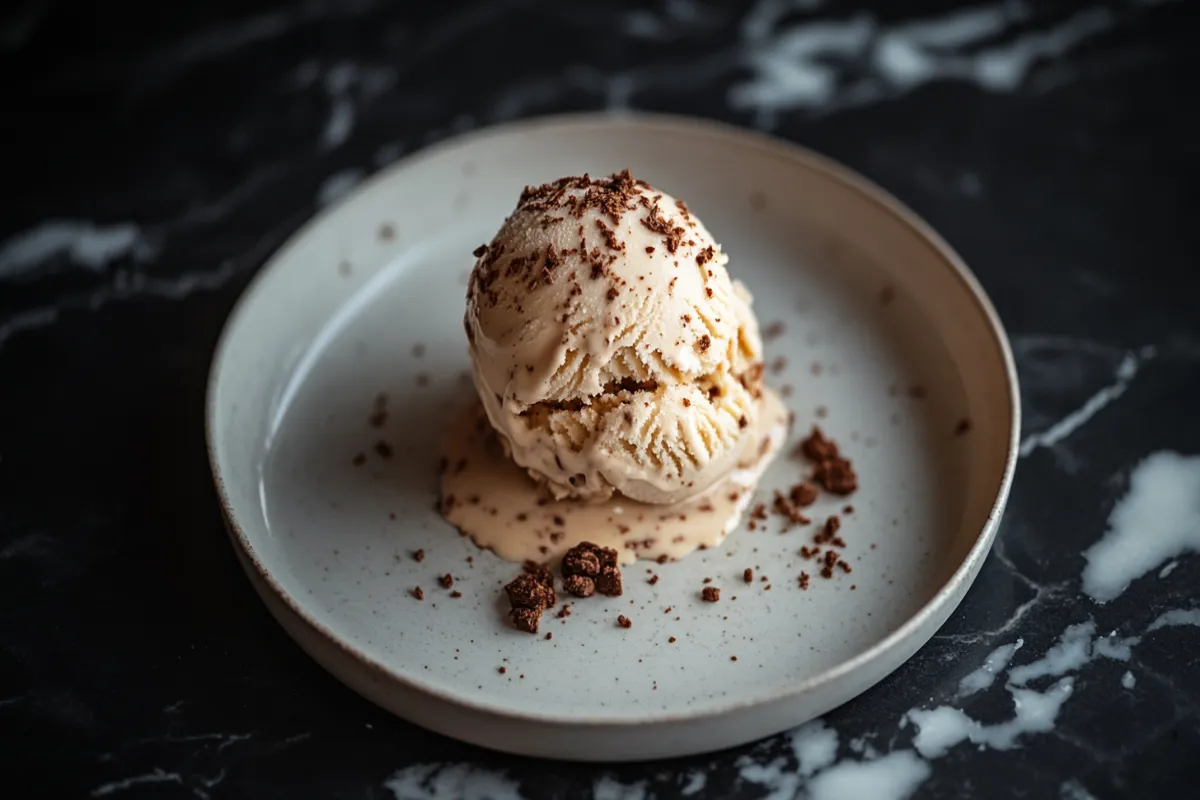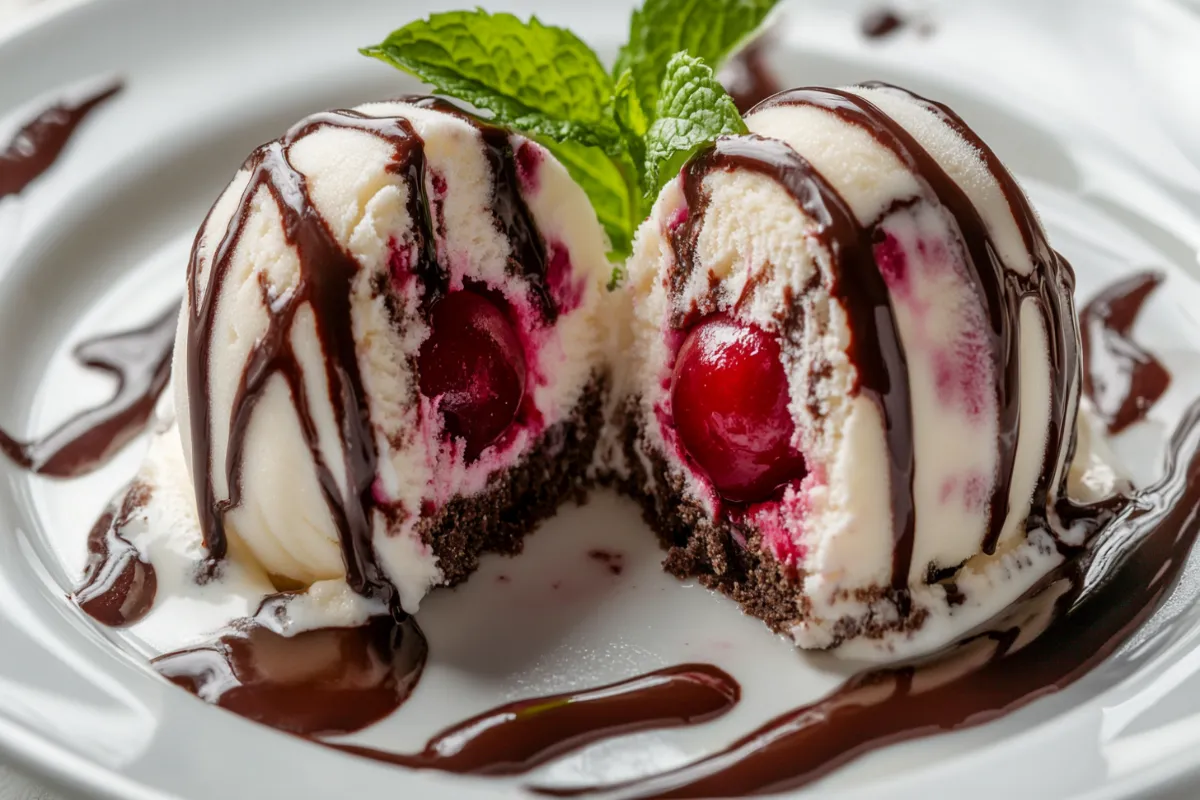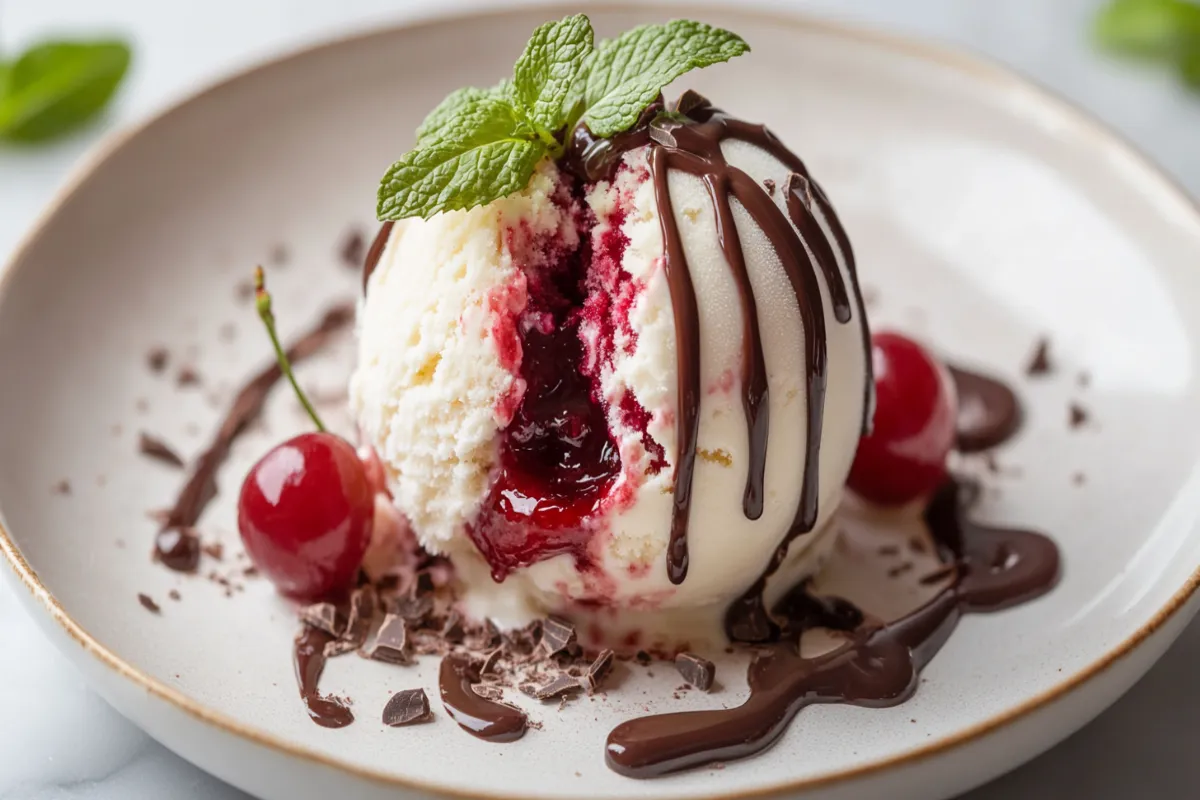Table of Contents
- Introduction: What is Tartufo Ice Cream?
- Origins of Tartufo Ice Cream
- Traditional Ingredients
- Gelato or Ice Cream Base
- The Surprise Center
- Chocolate or Cocoa Powder Coating
- How to Make Tartufo Ice Cream at Home
- Step 1: Preparing the Ice Cream Centers
- Step 2: Shaping and Freezing
- Step 3: Coating the Tartufo
- Popular Tartufo Flavors
- Chocolate and Vanilla
- Pistachio and Cherry
- Amaretto and Almond
- Modern Twists on Tartufo
- Tips for Perfect Tartufo Ice Cream
- Where to Find Authentic Tartufo
- Why Is Tartufo Considered a Luxurious Dessert?
- Frequently Asked Questions (FAQs)
- Conclusion: The Elegance of Tartufo Ice Cream
Introduction: What is Tartufo Ice Cream?
Tartufo ice cream is a beloved Italian dessert, famed for its rich flavors and intricate presentation. This dessert typically consists of one or two flavors of gelato or ice cream molded into a ball. Inside this creamy exterior lies a surprise filling, such as a cherry, fruit preserve, or a dollop of chocolate ganache. After forming the ball, it is coated with a hard chocolate shell, cocoa powder, or crushed nuts. The result is a harmonious blend of textures and flavors in every bite.
This frozen delight is more than just a treat; it’s an experience. When you cut into a Tartufo, you unveil layers of creamy ice cream paired with a flavorful center, a combination that perfectly complements the surrounding elements. Due to its intricate design and mix of flavors, Tartufo has become a favorite in upscale Italian restaurants and among dessert enthusiasts around the globe.
In the following sections, we’ll explore the origins of Tartufo ice cream, the key ingredients that give it its distinct character, and how to make this luxurious dessert at home. Additionally, we’ll dive into various flavor combinations and share tips to help you create the perfect Tartufo.
Origins of Tartufo Ice Cream
The origins of Tartufo can be traced back to the picturesque town of Pizzo in Calabria, located in southern Italy. According to local legend, Tartufo was first created in the early 20th century for a special occasion. An Italian gelato maker, facing the challenge of serving a unique dessert at a large gathering, came up with the idea of combining different flavors of gelato into a single, truffle-like treat. By encasing a fruity center and coating it in chocolate, he succeeded in creating a dessert that was both impressive and delicious.
In Italian, “Tartufo” means “truffle,” inspired by the dessert’s round, truffle-like shape and its association with luxury. Initially, Tartufo ice cream was a treat reserved for special events and celebrations, adding to its reputation as a sophisticated and luxurious dessert. Its success in Pizzo quickly spread across Italy and eventually the world.
While the traditional Tartufo recipe remains a classic, variations have emerged over time to suit modern palates. Today, Tartufo is known not just for its indulgent taste but also for its historical significance in Italian culture. The dessert continues to embody the essence of Italian culinary art, combining simplicity with elegance in every bite.

Traditional Ingredients
The magic of Tartufo ice cream lies in its combination of high-quality ingredients and careful craftsmanship. Each element plays a crucial role in creating the rich, multi-layered experience Tartufo offers:
Gelato or Ice Cream Base
The foundation of Tartufo is the gelato or ice cream used to form its core. Unlike regular ice cream, gelato has a denser texture due to its slower churning process and lower fat content. Traditional Tartufos usually combine two different flavors of gelato, such as chocolate and vanilla, hazelnut and chocolate, or pistachio and cherry. The smoothness of gelato complements the other elements in the dessert, offering a creamy backdrop to the surprise center.
However, some modern versions of Tartufo use ice cream as a base. In these cases, choosing a premium, dense ice cream helps maintain the dessert’s structure and richness. The gelato or ice cream’s quality directly affects the Tartufo’s flavor profile, which is why artisanal or homemade varieties are often preferred.
The Surprise Center
What sets Tartufo apart from other frozen desserts is the hidden core at its center. Traditionally, fillings like maraschino cherries, chocolate ganache, or fruit preserves are used. The surprise filling adds depth and excitement, creating an unexpected burst of flavor when you cut into the dessert. Additionally, this center contributes to the contrast in texture, enhancing the overall tasting experience.
For a modern twist, some recipes use salted caramel, nut butter, or even small pieces of chocolate truffle as the core. Regardless of the choice, the center should complement the surrounding flavors, bringing harmony to every bite.
Chocolate or Cocoa Powder Coating
Once the ice cream ball is formed, it is coated in a chocolate shell, cocoa powder, or crushed nuts. High-quality chocolate is essential for the coating, as it provides a crunchy contrast to the creamy interior. Dark chocolate is often used for its rich flavor, though milk or white chocolate can be used for a sweeter, milder taste.
The coating not only adds texture but also enhances the dessert’s visual appeal, giving Tartufo its elegant, truffle-like appearance. Some variations include rolling the dessert in crushed nuts or cookie crumbs to add an extra layer of flavor and crunch.
How to Make Tartufo Ice Cream at Home
Making Tartufo ice cream at home may seem complicated, but it can be a fun and rewarding process. By following these steps, you can recreate this indulgent dessert and even add your own creative touch:
1: Preparing the Ice Cream Centers
- Start by selecting two flavors of ice cream or gelato. Traditional combinations like chocolate and vanilla or hazelnut and chocolate work well, but feel free to experiment with different pairings.
- Using a small ice cream scoop, take a portion (about 1 tablespoon) of the first flavor and place it on a parchment-lined baking sheet. Then, create a small indent in the center of the scoop and add a filling, such as a maraschino cherry, fruit preserve, or chocolate ganache.
- Cover the filling with another scoop of the second ice cream flavor, and use your hands to shape it into a smooth ball. Repeat this process for each Tartufo you plan to make, ensuring that each ball encases its filling completely.
2: Shaping and Freezing
- After forming the ice cream balls, gently roll them between your palms to achieve a uniform, spherical shape. If the ice cream begins to soften, place the balls back in the freezer for a few minutes before continuing.
- Once shaped, place the balls in the freezer for at least 1-2 hours. This step is crucial as it helps the Tartufo maintain its shape during the coating process.
3: Coating the Tartufo
- Melt high-quality chocolate (dark, milk, or white) in a microwave or over a double boiler. Allow the melted chocolate to cool slightly, ensuring it remains liquid but not too hot.
- Remove the ice cream balls from the freezer. Using a fork or skewer, dip each ball into the melted chocolate, turning it to coat evenly. Let any excess chocolate drip off before placing the Tartufo back on the parchment-lined baking sheet.
- For added texture and flavor, you can roll the freshly coated Tartufo in cocoa powder, crushed nuts, or cookie crumbs while the chocolate coating is still soft. This step adds a layer of complexity to the dessert.
- Place the coated Tartufos back in the freezer for at least 1 hour, allowing the chocolate shell to harden completely.
4: Serving
- Before serving, let the Tartufo sit at room temperature for a few minutes. This allows the ice cream to soften slightly, making it easier to cut into and revealing the surprise center. For an elegant presentation, slice the Tartufo in half and garnish with fresh fruit, mint leaves, or a drizzle of chocolate sauce.
By taking the time to prepare each element with care, you can create a Tartufo that rivals those found in upscale Italian restaurants. The beauty of making Tartufo at home is that you can experiment with flavors, fillings, and coatings to suit your taste.
Popular Tartufo Flavors
Tartufo is celebrated for its versatility, with numerous flavors and combinations available. While the classic recipe typically involves chocolate and vanilla gelato with a cherry center, modern adaptations have expanded the range of flavor profiles:
Chocolate and Vanilla
This combination remains the quintessential choice for Tartufo lovers. The richness of chocolate gelato contrasts perfectly with the light, creamy vanilla. For the center, a maraschino cherry or chocolate ganache is commonly used, creating a traditional and crowd-pleasing dessert.
Pistachio and Cherry
For a nutty and fruity twist, pistachio gelato combined with a cherry or fruit preserve center is a delightful option. The nutty, slightly savory flavor of pistachio complements the sweetness of the cherry filling. To finish, the Tartufo is often rolled in crushed pistachios, adding a crunchy texture.
Amaretto and Almond
This variation caters to those who enjoy almond flavors. Using amaretto-flavored gelato, the dessert is filled with a core of chocolate-covered almonds or almond paste. The outer layer is coated with a mix of cocoa powder and crushed almonds, offering a luxurious and complex flavor experience.
Modern Twists on Tartufo
Recently, Tartufos with unique flavors like salted caramel, coffee and hazelnut, or mint chocolate have gained popularity. Some variations include fillings like caramel sauce, peanut butter, or even mini truffles. These modern twists highlight the dessert’s adaptability and make it a favorite for creative chefs and home cooks alike.

Tips for Perfect Tartufo Ice Cream
Creating Tartufo requires patience and attention to detail. Here are some tips to ensure your homemade Tartufo turns out perfectly:
- Use Quality Ingredients: The key to an exceptional Tartufo lies in the quality of the gelato, chocolate, and fillings. Opt for artisanal gelato and premium chocolate to achieve the best flavor and texture.
- Work Quickly: Ice cream melts fast, so work efficiently when shaping and coating the Tartufo. If the ice cream softens too much, place it back in the freezer for a few minutes to firm up.
- Experiment with Fillings: While maraschino cherries and chocolate ganache are traditional, don’t hesitate to try different fillings like salted caramel, nut butter, or fruit preserves.
- Serve Slightly Softened: Before serving, let the Tartufo sit at room temperature for a few minutes. This softens the ice cream and allows the flavors to meld, making it easier to cut into the dessert.
- Customize the Coating: Roll the Tartufo in different coatings, such as crushed nuts, cookie crumbs, or even edible gold flakes, for a touch of elegance and variety.
Where to Find Authentic Tartufo
If making Tartufo at home feels too ambitious, you can still enjoy this Italian delicacy at various places. In Italy, particularly in regions like Calabria, you will find artisanal gelaterias that craft Tartufo using traditional methods and high-quality ingredients. The town of Pizzo in Calabria is renowned for its Tartufo, offering an authentic taste of this classic dessert.
Outside Italy, upscale Italian restaurants and specialty dessert shops often include Tartufo on their menus. Some gelaterias in cities with vibrant Italian communities make and sell handcrafted Tartufos. Additionally, some gourmet grocery stores offer pre-made Tartufos, allowing you to bring a touch of Italian elegance into your home.
While the experience of enjoying a freshly made Tartufo in an Italian gelateria is unmatched, finding high-quality Tartufos at specialty stores or restaurants can provide an equally delightful experience.
Why Is Tartufo Considered a Luxurious Dessert?
Tartufo has long been associated with luxury due to its ingredients, labor-intensive preparation, and sophisticated presentation. High-quality gelato, rich fillings, and premium chocolate coating contribute to its indulgent nature. Moreover, Tartufo is handcrafted, requiring skill and precision to achieve its distinct layers and form.
Its association with Italian culture and special occasions also adds to its allure. In Italy, Tartufo is often served during celebrations, adding an air of elegance to the event. The careful construction of the dessert, combined with its visual appeal when sliced open, further solidifies its status as a gourmet treat.
For these reasons, Tartufo is not just a dessert but a culinary experience. Its complex preparation, use of premium ingredients, and luxurious presentation make it a true celebration of Italian dessert artistry.

Frequently Asked Questions (FAQs)
Is Tartufo always made with gelato?
While traditional Tartufo uses gelato, it can also be made with regular ice cream. However, using gelato gives it a denser and creamier texture, which is ideal for this dessert.
Can Tartufo be made in advance?
Yes, Tartufo can be made in advance and stored in the freezer for up to a week. This makes it an excellent option for preparing ahead of special events.
What is the best way to serve Tartufo?
For the best experience, let Tartufo sit at room temperature for a few minutes before serving. This softens the ice cream slightly, making it easier to cut and enhancing the flavors.
How do you store leftover Tartufo?
Leftover Tartufo should be stored in an airtight container in the freezer. When ready to eat, let it thaw for a few minutes to regain its creamy texture.
Conclusion: The Elegance of Tartufo Ice Cream
Tartufo ice cream is a timeless Italian dessert that perfectly balances creaminess, crunch, and a delightful surprise center. Its combination of flavors and textures, along with its sophisticated presentation, makes it more than just a frozen treat. Whether enjoyed in an Italian gelateria, a fine restaurant, or made at home, Tartufo offers a unique dessert experience that celebrates the artistry of Italian cuisine.
By understanding its origins, ingredients, and preparation, you can appreciate the care and craftsmanship that go into creating Tartufo. With endless flavor combinations and the ability to customize its filling and coating, this dessert provides an opportunity for creativity and indulgence.
So, the next time you crave something sweet, consider trying or making Tartufo ice cream—a true celebration of elegance and flavor.

